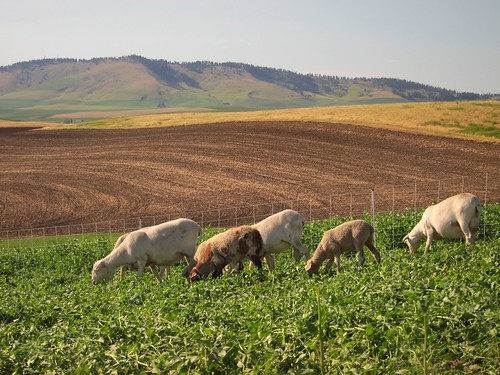
Grazing livestock may soon be a common sight in the Palouse region of southeastern Washington, usually known for its rolling hills and grain production.
Jonathan Wachter, a soil science doctoral student at Washington State University, has been working with a local farm to improve the competitiveness of organic mixed crop-livestock systems and their potential adoption by growers in a conventional grain-producing region.
The study is supported by a $695,078 National Institute of Food and Agriculture (NIFA) grant awarded to Washington State University through the Organic Transitions (ORG) program.
“Since 2001, ORG has provided support to researchers across the nation to help improve the competitiveness of organic crop and livestock producers as well as those who are adopting organic practices,” said Mat Ngouajio, NIFA national program leader for plant production. “This support has also helped better understand ecosystem services of organic agriculture.”
Wachter has been working on this five-year project with wheat farmers Eric and Sheryl Zakarison since 2012, growing wheat, peas, perennial species like alfalfa, and sheep in a tightly integrated system to demonstrate how integrated livestock farming can contribute to sustainability goals.
“They are the ones doing the research on their farm because they want to improve their soil,” Wachter said. “All I’m doing is putting their ideas into practice in a research context to generate the data that backs up some of (their ideas). They’re the real innovators.”
Using 100 of the Zakarison’s 1,300 family-owned acres, they are experimenting by increasing and retaining soil nutrients, adding biodiversity, reducing greenhouse gas emissions, and reducing soil erosion.
While large-scale grain production is an important source of food, it sometimes comes with an environmental cost. For example, water and air pollution problems can result from soil erosion caused by soil tillage and from the excessive use of nitrogen fertilizers and synthetic pesticides, while growing perennial grasses and legumes can reduce erosion, increase biomass and soil organic matter content.
The Zakarison’s 65 white Dorper ewes then eat the grasses and legumes, turning it into milk for lambs and meat for local markets, all the while helping the soil system reutilize nutrients. The sheep and cover crops also assist with weed management.
Wachter’s study compares three different production schemes. One treatment follows a conventional rotation of peas, winter wheat, and spring wheat with minimum tillage and the use of herbicides and synthetic fertilizers.
In an organic treatment, livestock are allowed to graze after three years of growing pasture, supplying nitrogen for the next planting of grain crops. Finally, a hybrid treatment includes livestock plus fertilizer – and herbicides as needed. Austrian winter peas replace the conventional rotation of spring peas and, instead of harvesting a pea crop, sheep graze the crop to return nutrients to the soil.
Over the past three years, Wachter said, the organic treatment has been most profitable and shows carbon has increased in the soil, rather than released as a greenhouse gas into the air. The verdict is still out on the hybrid scheme.
The WSU Center for Sustaining Agriculture and Natural Resources provides more information on integrated livestock farming.
NIFA invests in and advances agricultural research, education, and extension and seeks to make transformative discoveries that solve societal challenges.
